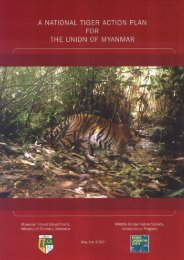Download - Global Tiger Initiative
Download - Global Tiger Initiative
Download - Global Tiger Initiative
Create successful ePaper yourself
Turn your PDF publications into a flip-book with our unique Google optimized e-Paper software.
At national level<br />
Snow Leopards are protected by law in each of the 12 range States, with the possible exception<br />
of Afghanistan (see below). However, in some countries the relevant legislation may not always<br />
be effective. For example, in Pakistan, protective legislation for Snow Leopards is not applied<br />
at the national level and, according to the CITES National Legislation Project, the legislation of<br />
Afghanistan, Mongolia, Nepal, Pakistan and Uzbekistan was “believed to generally not meet the<br />
requirements for the implementation of CITES” (Anon., 2002e).<br />
Afghanistan<br />
No up-to-date information is available on the legal status of Snow Leopards in Afghanistan.<br />
After the military intervention in Afghanistan, launched after 11 September 2001, the<br />
Agreement on Provisional Arrangements in Afghanistan Pending the Re-establishment of<br />
Permanent Government Institutions, signed in Bonn, December 2001, (the “Bonn Agreement”)<br />
established the Afghan Interim Authority (Anon., 2003a). Under this authority, the country’s<br />
legal system still operates within the context of the constitution enacted by the monarchy in<br />
1964. Existing laws stand, provided that they are not inconsistent with the Bonn Agreement. In<br />
this regard, the Nature Protection Law of 1986 (amended in 2000) and the Hunting and Wildlife<br />
Protection Law of 2000 provide an important framework for governance, but a post-conflict<br />
environmental assessment undertaken by UNEP in 2002 concluded that, “the legal status of all<br />
protected animals in Afghanistan is currently in question and no management is taking place to<br />
protect and conserve their ecological integrity” (Anon., 2003a). A project has been initiated<br />
with the participation of UNEP to draft legislation for environmental protection (Baker, 2002),<br />
but this legislation has not yet been developed. In the absence of new environmental laws, the<br />
transitional authority in Afghanistan has issued various decrees banning hunting and timber<br />
harvesting, but difficulties have been reported in the enforcement of these decrees (Anon.,<br />
2003a).<br />
Bhutan<br />
The hunting of Snow Leopards is prohibited in Bhutan through the Forest and Nature<br />
Conservation Act, 1995. Killing of a Snow Leopard can result in a fine of BTN15 000 (approximately<br />
USD309), which is among the highest fines for killing an animal in Bhutan and equal<br />
to about twice the annual cash income of a wildlife warden (around BTN7000 or USD150)<br />
(D. Yonten, Nature Conservation Division, Department of Forestry of Bhutan, in litt., May 2003).<br />
China<br />
The Wildlife Animal Protection Law (WAPL) of the People’s Republic of China (1989) and the<br />
Enforcement Regulations for the Protection of Terrestrial Wildlife of the People’s Republic of<br />
China (1992) are the two principal laws providing full protection to Snow Leopards in China.<br />
The species is listed as a Class I protected animal under the WAPL, which means that:<br />
•<br />
•<br />
hunting of Snow Leopards constitutes a criminal offence and<br />
sale and purchase of Snow Leopards or their products is strictly prohibited (although<br />
scientific research, domestication, breeding, or exhibition is allowed with a permit<br />
(O’Connell-Rodwell and Parry-Jones, 2002).<br />
FADING FOOTPRINTS: the killing and trade of Snow Leopards 15

















